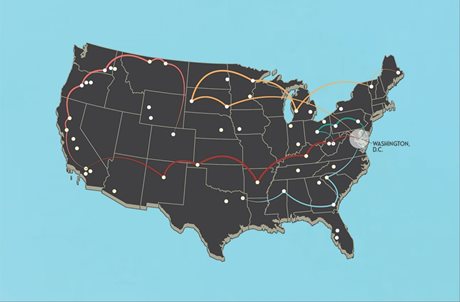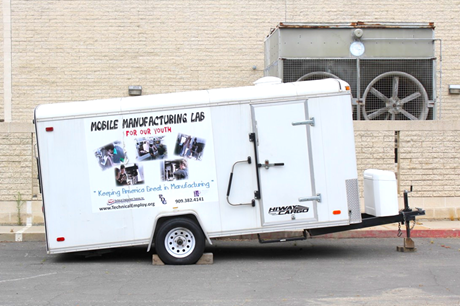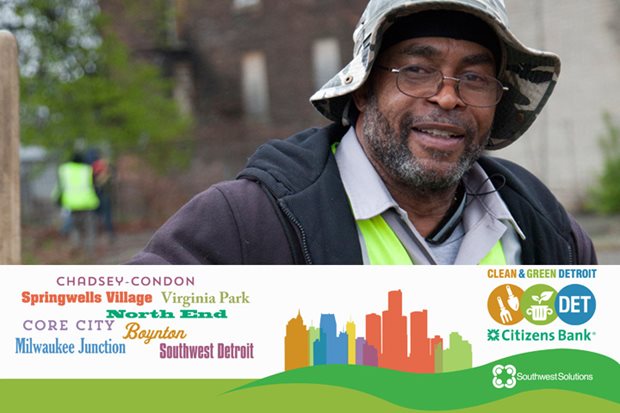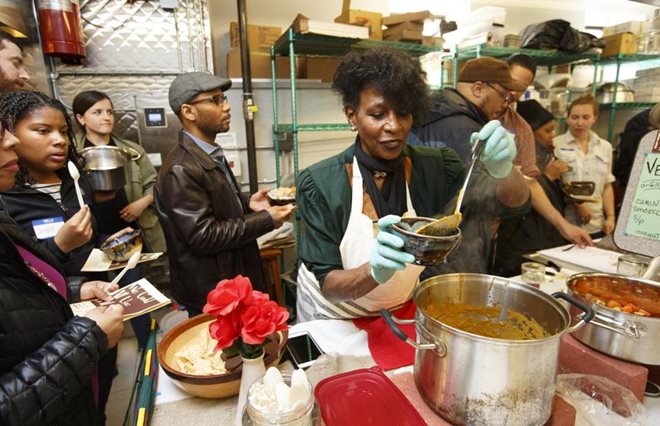Imagine a journalist for an influential, national publication who not only shuns big metropolises for mid-sized towns, but is intent on ferreting out and telling “good-news stories.” I am a former reporter and that surprises even me.
 |
| Towns visited by James and Deborah Fallows |
James Fallows will be the keynote speaker at the NeighborWorks Training Institute Wednesday symposium, “Creating Places of Opportunity: Investing in Neighborhoods” (ML924), in Detroit Aug. 10. He and his wife have already written about 24 towns on their do-it-yourself tour, and in the run-up to the NTI, they’ll be visiting Louisville, Kentucky; Dayton, Ohio; and Holland, Michigan. Why have they turned into small-town nomads, and what are they looking for?
“I’ve long been interested in the ‘how and why’ behind resilience and reinvention—basically, the things that do and don’t work,” explains the one-time speechwriter for Jimmy Carter who has lived in both Japan and China, exploring the dynamics behind what drives local economies. “What I’ve observed is that as a whole, while America may seem to be going to hell, a wide range of people, of different generations and races and political outlooks, believe their city is on the upswing, and that their own efforts can help speed that trend. That story is just not being told.”
Why do the media cover only the negative?
As a former journalist, I chuckle when I hear that question. Journalists’ job is to cover the news, and fortunately, “things working” is still the norm, and “things not working” is the news. It’s particularly bad during a presidential election year, when the party out of power seeks to paint the most negative picture possible. It’s also true that if we are honest with ourselves, there is a bit of the voyeuristic “ambulance chaser” in all of us.
 |
| San Bernardino (photo credit: The Atlantic) |
So how can nonprofits and others doing good work get the media coverage they deserve? Fallows offers a few suggestions:
- Pitch the “big picture,” not just what your organization is doing. Identify a broader challenge or trend into which you can tie that is impacting communities across the country.
- Highlight other examples of innovative solutions, rather than just your own. Journalists don’t want to write what amounts to an “ad” for one organization, so you’ll have better luck, and build a better long-term relationship, if you don’t just pitch yourself.
- Build credibility by discussing what doesn’t work, or lessons learned, as well as your successes.
- Look for ways to give the story more “texture, ” since the media often perceive good news stories as “sappy.” Build some unexpected twists into your story, if possible, and include observations about why and how what you’ve done might work in other places.
Nurturing small businesses
Although a majority of finance news focuses on industry titans and the efforts of towns to attract them, James writes, “I now see (the vibrancy of America) as an archipelago of start-ups and reinventions.” In fact, John Dearie, co-author of “Where the Jobs Are,” argues that new-business formation is the single most important indicator of future employment trends. “All net new job growth within the U.S. economy has come from firms in their first five years of existence,” James points out. “Big, established firms employ a lot of people, but the increase in jobs overall come from new firms.”Many NeighborWorks network members help residents plan for or start new businesses through financial-capability programs. For example, Southwest Solutions runs a service called ProsperUS Detroit, an entrepreneurial training and small-business lending program for residents, particularly African-Americans, Arab-Americans and Latinos. The training program guides entrepreneurs through the business-planning process step-by-step. It also helps them create a peer and professional support system. Graduates who intend to locate their business in one of the organization’s five target neighborhoods are eligible to apply for up to $15,000 for start-up businesses and up to $25,000 for existing businesses. Legal, marketing, accounting, HR, design and IT consultation also is available.

Creating ‘gathering places’
In her own article for The Atlantic, Deborah Fallows writes about the importance of “gathering places”—often, the public library. She writes: “Libraries serve as anchors in times of distress: The library in Ferguson, Missouri, kept its doors open even when schools were closed, and libraries in New Jersey became places of refuge after Hurricane Sandy.”Nonprofit community development organizations often serve the same purpose. For example, The Neighborhood Developers in Chelsea, Massachusetts, encourages neighbors to get to know each other through its First Thursday Community Dinners, potlucks held at its offices. And Nuestra Comunidad Development Corp. in Roxbury, Massachusetts, supports Haley House, a “socially conscious coffee house.”
 |
| A soup event at the Haley House |
“We work the management of Haley House to make this café a thriving business that not only serves healthy and organic breakfast and lunch every day, but uses food and the power of community to break down barriers between people, transfer new skills and revitalize neighborhoods,” says Monica Dean, director of resident services and community organizing.
Welcoming diversity
“We saw the shift all around the country: older people whiter, younger people darker,” writes James. “But based on everything we could see, the problems of immigration that presidential candidates have seized on for political advantage were largely a ‘rest of America’ problem. In 2014, Gallup found that 65 percent of Americans thought levels of immigration should stay the same—or go up.”Helping newcomers integrate, as well as sharing their cultures, is a core competency of many NeighborWorks members, as described in a recent IdeaWorks blog post on refugee resettlement.
Recognizing the value of art
“Perhaps the topic on which I’ve most changed my mind through our travels concerns the civic importance of the local arts,” says Fallows. “There is more going on, in more places, than I imagined.” In city after city, the couple saw vitality directly linked to a “determined use of the arts.”One example from the NeighborWorks network is Waco, Texas, where a nonprofit venture called ArtPlace, housed in a long-vacant movie theater, was announced June 26. A nonprofit commercial enterprise, ArtPlace was “born” from a collaboration between Cultural Arts of Waco and NeighborWorks Waco. It will be an all-purpose space for children’s and adult art classes, art shows and movie showings—eventually serving as an “anchor” for Elm Avenue, with a cafe and a sculpture park where people can come to hang out and build community.

Finding ‘local patriots’
“A standard question we’d ask soon after arrival was ‘Who makes this town go?’,” writes James. “The answers varied widely. But what mattered most was that the question had an answer. And the more quickly it was provided, the better shape the town was in.”Finding and providing professional development to those “local patriots” is what NeighborWorks America’s Community Leadership Institute is all about. And the Dorothy Richardson Resident Leadership Awards recognize and honor the best of them.
Bridging public and private interests
“Through the years, I had assumed the term ‘public-private partnerships’ was just another slogan, or a euphemism for sweetheart deals between Big Government and Big Business,” writes Fallows. “But in successful towns, people can point to something specific and say, this is what a partnership means.”Cross-sector collaboration is a major focus across the network and in fact was the central theme of the NeighborWorks Training Institute symposium in February, which highlighted many examples.
Cultivating a clear civic identity
“Every successful city has a story,” says Fallows. “As with guiding national myths, the question is not whether these assessments seem precisely accurate to outsiders. Their value is in giving citizens a sense of how today’s efforts are connected to what happened yesterday and what they hope for tomorrow.”This is exactly what NeighborWorks America helps foster through its neighborhood marketing program.
“We believe vibrant communities are places where residents and stakeholders feel confident in the future of their neighborhood,” explains Paul Singh, director of community stabilization. “This confidence inspires people to dedicate time and energy to nurturing the positive assets of the neighborhood and spreading the word.”

